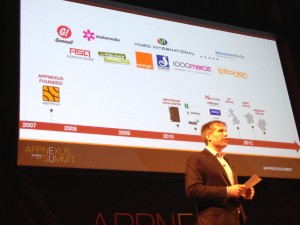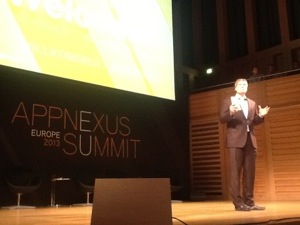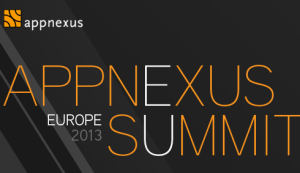 We often talk about bidding and we think of a single ad space. What do you think about multi-bids ? Is there a way to implement it today ? How can we improve things ?
We often talk about bidding and we think of a single ad space. What do you think about multi-bids ? Is there a way to implement it today ? How can we improve things ?
There is two issues here : one is multi-bids, the other is multi-tags. From the very beginning, we built AppNexus to support both multi-tags and mutli-bids. We always encouraged the industry to work this way. Even at Right Media, I was pushing at this internally. The reason why it is not doable yet is that it is complicated to implement and most actors have not put the effort to get to that level.
What would be the advantage for the industry to implement it ?
Quantity : every time you do not multi-bid, you are losing traffic. You are losing revenue. Inefficiency hurts everybody. Anything that make the system more efficient benefit to everyone. AppNexus has supported it for a long time but more people need to talk about it.
How do you define AppNexus. Are you a DSP, a SSP, an adexchange ? It is hard to define from the outside.
Our technology responds to different business models that are present in the market. We are a technology stack company that allow multiplier players in the industry to operate their business. We are unique. We are not involved in the media business. We are the technology inside the system just like Intel microchip in a computer or Mac.
Today we have 30 providers on the market, do you think it is too much because you have to connect to those different provider?
We are able to keep up with the evolution of market as we are a technology company. This is our mission to keep our technology up to speed with new technologies / inventories. For instance, Facebook will come up with something new. Twitter is launching its ad exchanges. We spent over 100 million dollar building our technology and It is why we have more than 250 engineers working together to take care of that part of the business for the industry.
 Why Open RTB protocol is not working?
Why Open RTB protocol is not working?
The issue is that everyone implements it differently. Let’s take a simple example of categorizing impression. If I send you an impression saying it is news, and someone else send you the same impression and says it is entertainment. What do you do? As a conclusion, it is not about protocol. I say it is fraud versus someone else might not consider this as not being fraud. Protocol does not mean that everyone will be doing RTB the same way. The truth is protocol is a language interpreted by your computers but the way it is used by player will change from player to player.
For instance, on mobile where Open RTB is more popular, everyone does it a little differently. It is really more about what is in the protocol and what is in the request. We are going to see standardisation and especially as RTB is becoming a commodity. As a matter in fact, AppNexus is commodity business. Anyone playing in this industry saying there are not a commodity business, there are dead. The only player that can compete with AppNexus is Google.
For instance, Apple can afford to build its own chips because it is one of the most valuable company in the world but they are not doing it. Same for Microsoft which could decide to do its own operating system and hardware. But at some point, you are as big as Microsoft. Think about that in our space, where companies are 100 times smaller. I am going to build a sales team, I am going to build proprietary data, I am going to build proprietary technology, I am going to build proprietary relationship with sellers. It is an insane strategy. Only Google can do that.
When we meet players, we ask this question : can you really keep up with what Google is building? Can you keep up with the 50 billion dollars of printing with searching? If not, you need to partner with AppNexus. It is why we are not going to have many players in the industry in a couple of years from now. the market will consolidate.
Google has strong synergy between its DSP and adserver. What is your plan on the adserving side of the business ? Is it an advantage in the business in your opinion ?
There is a different story on the buy side and the sell side.
What we are very strong as an adserving company is powering intermediaries. So we do not have a great agency adserver like Atlas and DFA and we did not focus on creating a great adserver for publisher like DFP. What we are build is a tools for players in the middle : Trading desk, DSP, SSP, and networks. For instance, hi-media and Wedads are using AppNexus as their primary adserver.
We deeply believe that your adserver has to be integrated with your exchange technology.
Today, we are not equivalent to DFA for instance as we do not have some features but we will develop those for our clients if they need it. As a result, we will compete more and more in those markets.
We almost do it accidentally and you can do it in the platform but it is not easy for now. But we will make it easy. It is not because we are trying to be an agency adserver. It is because agency are questioning why using two different technology.
We are discussing with Atlas and Media Mind to see how we can better integrate their adserver to our technology for ease of use for our clients. In the end, many client do not need both. That’s the future.
This is where Google has been very successful in integrating Invite with DFA and Admeld with DFP.
Google is weak to answer the needs of the players in the middle whereas AppNexus is strong in that area. For instance, if you are a publisher, DFP is the market bidder but if you are a network, then AppNexus is the market leader. For Orange for instance, they are both a network and a publisher. What platform makes more sense? From a publisher stand point, DFP is perfect but when you integrate the network it is not answering the need. Another example is audience extension. Why can’t I buy more reach for specific campaign? It is harder when you use a DFP.
To sum up, we are strong with intermediary players and it is an asset that we will keep investing onto.
 During the Summit, you did not talk about video. How do you see the video eco-system? And how do you see AppNexus position on the market ?
During the Summit, you did not talk about video. How do you see the video eco-system? And how do you see AppNexus position on the market ?
The answer is focus. Meanwhile we are the largest ad technology company, we are relatively small compared to Google. While it is 5 billion dollars industry globally today, most of that is hand sold at high CPM to TV buyers. The non-garanteed volumes aside from Youtube is very small.
Look at Adap.tv, Tubemogul, it is actually a very thin market and it is why there not many players.
When we looked at mobile versus video, it turns out that mobile is 3 times bigger than video.
Last year, we expanded to Europe. This year we are investing on mobile and starting Asia-Pacific and next year we will focus on Asia Pacific and video.
 What is your approach on tracking without cookies ? What is take for AppNexus ?
What is your approach on tracking without cookies ? What is take for AppNexus ?
Today, we don’t finger print. We obide by user’s cookie settings because that is the best indication of their preferences. In this case, we might not be as competitive as others but we are very concerned about user’s privacy. Because it give no control to user on how their information is being used. I have 2 takes on this :
1. I agree with what Mike said on stage today : « We have a strong obligation to protect user’s privacy » and as an industry we have not been very clear about that.
2. I think the debate we are having in the us about Do Not Track is an indication of that. It is a sign that the industry is trying to not address the issue and push Do Not Track as an unused preference like clearing your cookies.
3. I think user should know exactly what data is being tracked.
I think we separate this issue in three points :
a. Publisher: What information is used when I visit a website. The publisher can easy convey that message as a visit the site and give the opportunity to know and accept when information is used.
b. Advertiser: If I visited an advertiser’s site, as a user, I can accept to receive an ad from that site because I physically visited the site. I think it has to be disclosed and there should be control about it but it is fair the user because the users engaged with the site initially. It is a reasonable user experience.
c. Third party : What I do not like and I don’t feel comfortable is when there is a third party involved. For instance, I go to your site and I see an ad for FIAT because I have visited and car site before. I understand that it works but it arising questions on who’s tracking me and how.
For instance, I shop for a baby straddle for a baby shower. I get targeted with banners selling baby products. That arises a lot of questions. Who is tracking me? If is not the advertiser, it is not the publisher. Who is this then?
I think there is an easy solution. Let’s both from a policy and technology perspective stop creating profiles. Google does it. Others does it. AppNexus for instance does not create profile and focus on first party data. I think it will not impact business at all. Maybe some companies will go out of business but publisher will still use their data and advertiser will use their data. And in the end, user will know there are 3 options to ad showing.
1. Publisher
2. Advertiser
3. No data was used
That to me is a defendable solution to stand in front of a government. We could say : « We are doing something that consumer controls ». For instance, you do not want an ad from an advertiser opt-out.
I think this is the discussion to have instead of trying to replace cookie technology that will not solve the bottom line.
We will use technology ID if we have to but I do not want to. I would rather have a policy based decision that will be supported by the browsers that allow me to be a great advertising company without identifying users.
We have been talking to browser technology about a technology solution but we are not sure it will be used as a solution.
 When we take a look at attribution, it’s key to differentiate a user who has seen a banner or not. When Appnexus will integrate the visibility in his platform ?
When we take a look at attribution, it’s key to differentiate a user who has seen a banner or not. When Appnexus will integrate the visibility in his platform ?
I am not completely confident that our view ability works. We tested everything in the market. We are not sure that anyone can conclusively say an ad was seen or not seen. Once we can say that our technology, we will include it into our bidding algorithm. We will introduce new pricing model that will say for instance Pay per viewed as apposed to pay per impression. We think about roughly viewed metrics. It is all about making sure that the technology works. I am expecting this from us and others to come. I do not think that the world of unseen ads make any sense. It will take some time because of technology and practices. We keep testing everyone that comes out because we want to find technology that works. Part of it is publisher participating. If a publisher say I will give you a clear yes or no, that will make out life easier. Trying to guess is not the solution. Probably until next year.
I totally agree with you Attribution only make sense on seen impressions.
One last question, is there a main innovation you would like to talk about?
I think TANGO and Mobile are really our main innovations and will keep discussing in upcoming summits.
Pierre Berendes








